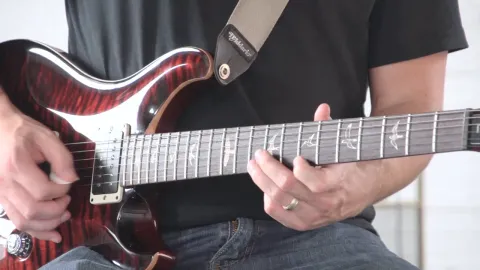Improvising 301 - Progressions

In our first improvising lesson, we discussed soloing over one chord vamps. But very few songs are only one chord. Playing over progressions is a skill you must master to be a good player. Too many players just pick one pentatonic shape for an entire song and plunk around in it without regard to chord changes. Now to be fair, some cool sounds and phrases can be made in this manner, but a real improviser has an arsenal of tools at their disposal. We will not be one trick ponies.
Let's take a I IV V in A minor in fifth position. Our chords will be A minor, D minor, and E minor respectively. Basically, the concept is to switch to the pentatonic scale that corresponds to the chord that is being played. So, over the A minor chord we will be playing A minor pentatonic pattern 4. Remember to play "about" or "at" your roots. When the chord changes to the IV chord (D minor) you need to switch to D minor pentatonic. We can reach a D minor pentatonic shape in this position without moving up or down the neck by utilizing our "closest moves" concept to go to D minor pattern 2. You could jump to any D minor pattern, but for right now focus on being economical. It will help you learn the neck.
When playing over the IV chord realize that YOUR ROOTS HAVE CHANGED. You are in a new pattern. Play accordingly. Play "about" or "at" your new roots (D pattern 2). Do the same thing when you go to the V chord (E minor). Your "closest move" is E minor pattern 1. Really think about your new roots. Accentuate them. Don't be vague when switching chords. Nail your new roots. Really sell the change! This concept is applicable to any progression in any key.
It is also important to note that the difference between each of these scales is only one note. In addition to the roots changing, be sure to accentuate the differences in the scales themselves. For example: when you switch to D minor pentatonic from A minor pentatonic, the note that changes is E (the fifth of A) changes to F (the minor third of D). Because the F is a chord tone of the D minor chord, when you accentuate this note you are spelling out the chord and making the change more obvious than if you didn't.
Now, apply the same technique to a major I IV V and a I VI II V progression.
Just like all of our other lessons I want you to try this in every position on the neck. Go up and down the entirety of the neck improvising in different patterns nailing the root movements. Play along with each of the jam tracks below. Really try to feel comfortable playing in different keys, over different progressions, and on any part of the neck. Many people call this style of improvising "box" soloing. This is a great way to start seeing how tonality changes as you move around the neck and through different progressions. Love the box. Be the box. But always be thinking of your roots.
Jamtracks:
1. C major I IV V
2. A minor I IV V
3. C major I VI II V
4. G major I VI II V